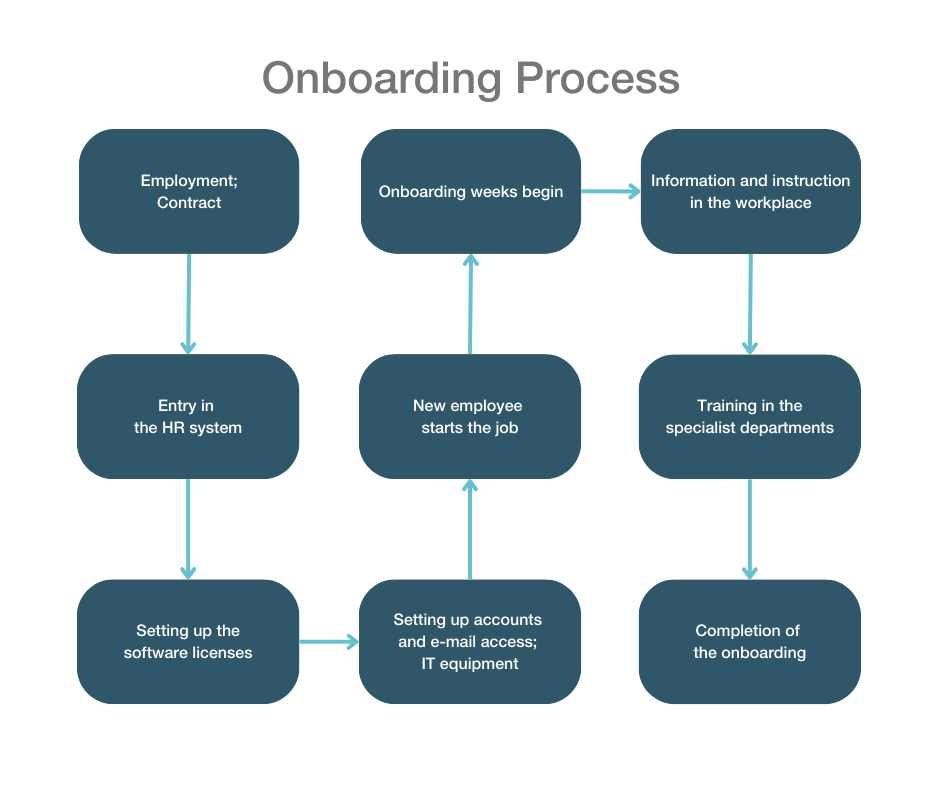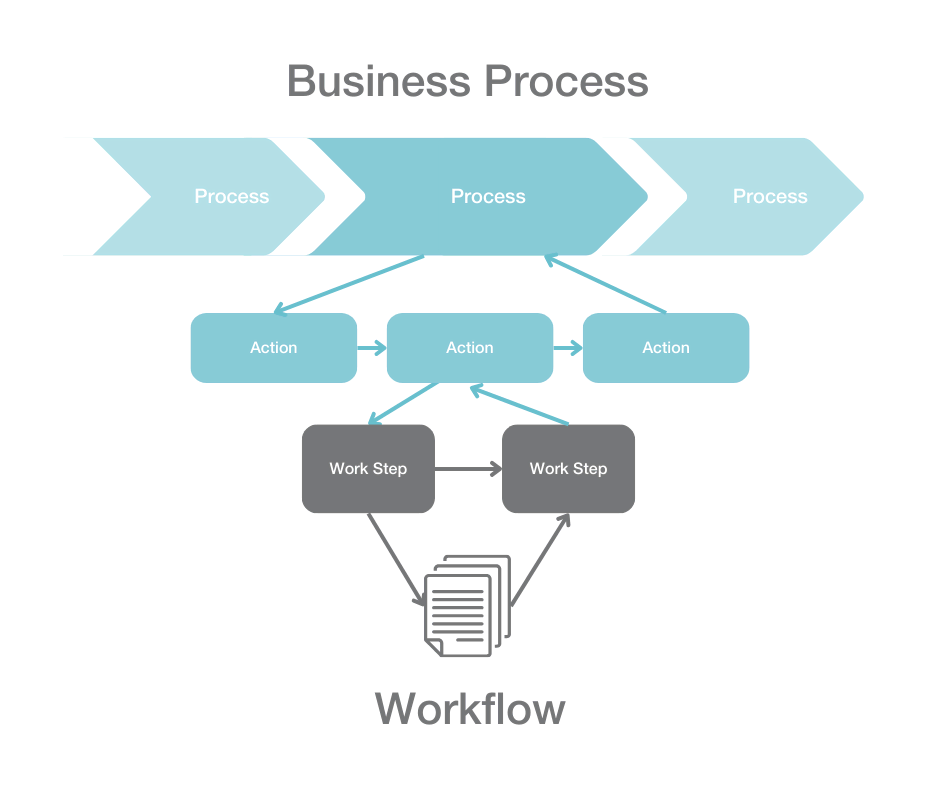

Definition: Workflow
A workflow is a sequence of work steps that aim to achieve a specific result. A workflow is often subordinate to a process or a project.
Depending on the requirements, workflows are structured differently – for example, steps may be done sequentially or in parallel to one another.
Background: Why workflows?
Workflows are omnipresent in the modern working world and are more than just a buzzword. There have always been certain workflows for carrying out tasks. However, the term only really came into use with the digitalization of the working world: in the 1980s, when more and more computers, emails and digital systems emerged, the concept took hold.
Relationship to technology
The term workflow has always been associated with technology. It is therefore hardly surprising that today it is mainly used in connection with software solutions.
Workflows are used to organize, structure and make work processes more efficient – always with the corresponding outcomes (goals) in mind.
Types of workflows
There are various types of workflows, which differ depending on their context.
- Process-oriented: Here, a workflow belongs to a specific process. As individual processes are often structured in the same way, the associated workflows are also repeated.
- Project-related: In this case, the workflow is assigned to a project. Here too, it is mainly recurring tasks that occur within the scope of the project.
- Case-related: Such workflows are initiated separately and without repetition. They are used to solve a specific problem or fulfill a specific task.
Workflows also differ according to the way they are executed. For example, they can be parallel (several tasks next to each other), linear or sequential (straight from one task to another) or branched (different paths depending on results).
Workflows can also be differentiated according to whether they are fully automated, partially automated or entirely manual.
Workflow examples
But what does a specific workflow look like? There are plenty of examples, like this one:
- When manufacturing a car, a team performs the same steps over and over again; one part after another is added (process-oriented and linear).
- For a marketing campaign, different teams of specialists develop new concepts in several steps (project-oriented and parallel).
- Customer service has to deal with a specific problem. To resolve it – depending on the success of the previous actions – various steps are taken (case-oriented and branched).

What is workflow management?
How can workflows be effectively planned, controlled and optimized? Workflow management deals with this question. It is about systematically organizing and structuring workflows in order to avoid errors and streamline recurring processes.
The importance of continuous improvement
Effective workflows are essential to ensure functional processes and ultimately achieve corporate goals. These form the foundation for value creation, success or simply proper business operations.
Workflow management now improves these processes, for example to enable a more efficient and goal-oriented approach. Workflow management systems and automation help companies benefit from smooth, intelligent workflows.
Good workflows save a lot of time, contribute efficiently to objectives and bring about clear successes.
An example of workflow management
As diverse as workflows are, and as dependent on the industry and application, they all have one thing in common: they are dependent on good planning, organization and control.
Without good management, the work may run, but it will not necessarily reach its destination, or will do so only in a roundabout way.
For example, when complaints are received by customer service, the agent responsible is often unable to provide a solution directly. If no workflow that defines a series of possible actions for the agent to take is provided for such a case, this increases the risk that the complaint will remain unprocessed for too long and the customer may even churn.
Good workflow management, on the other hand, immediately initiates a series of targeted steps. The workflow may even be branched – different steps are used depending on the success of an activity. With the right software support, not only does the agent have a good overview, but may even be able to speed up their response to the customer since some steps are automated. This enables customer service to resolve the complaint quickly and stabilize the customer relationship.
Workflow management and process management: the differences
Workflow management and process management are not the same thing, even though the two terms inevitably belong together.
- Process management (strategic) focuses on higher-level business processes. The aim is to optimize these in order to be successful as a company.
- Workflow management (tactical), on the other hand, deals with the individual work steps. These are grouped into workflows and optimized through to automation. A workflow can, but does not necessarily have to be part of a higher-level process.
Process = macro level – What is to be done?
Example: process a customer inquiry
Workflow = micro level – How to do it? (step-by-step sequence)
Example: Obtain and record information – Make entries in the system – Create a new ticket – Inform colleague XY – Notify the customer
Several workflows (subordinate level) can be assigned to one process (higher level).

The advantages of workflow management
Dedicated workflow management increases the performance of companies. As functional workflows are symbolically their lifeline, efficient processes support their health and growth.
Below are the key benefits of workflow management.
Greater efficiency
Essentially, well-designed workflows result in process optimization: by making workflows positive and goal-oriented, improvements are also made to higher-level processes. The same applies to the project context – workflows are largely responsible for the success of the entire project.
As they therefore tend to produce better results in less time, good workflows increase efficiency. Tasks can be completed in a more organized, structured and targeted manner, which benefits companies at all levels.
Avoiding mistakes
Mistakes are annoying – especially when they could have been avoided. Often the solution is simply organized workflows. They improve information flows and ensure that everyone involved has taken into account all work steps and relevant materials. Errors, such as forgetting individual tasks or compiling the wrong information, can be avoided altogether or corrected more quickly.
Better collaboration
When companies manage and control workflows in a targeted manner, employees can generally work together better as clear responsibilities, communication channels and shared work platforms are in place. For example, individual team members can communicate with each other more regularly and easily, which improves the corporate culture and deepens relationships. As good workflows make collaboration more pleasant, better results can be expected due to the resulting higher motivation.
Transparency
The principle is quite simple: if we have a clear goal in mind, it is much more likely that we will achieve it. This hits the nail on the head when it comes to workflow management – it increases the overview and creates deeply purposeful communication. This creates a high level of transparency that companies can use both operationally and strategically.
Stronger compliance
Complying with legal regulations and guidelines is not only a good idea, it is often mandatory. Clear workflows with unambiguous responsibilities safeguard this area. This makes it easier to create data-based audit trails and monitor specific results.
Tips for effective workflow management
Good workflows are not a sure-fire success. However, they can be implemented quite easily if a few important points are taken into account. For example, the path to optimized workflows usually leads to suitable workflow management systems including automation (more on this below).
These points are also important for effective workflows:
- Monitoring – In order to optimize workflows, companies need to take a close look at them and identify areas for improvement.
- Clear communication – Good workflows depend on a successful exchange between those involved. It is therefore beneficial if communication is clear and effective. The right collaboration tools, goal-oriented meetings and regular consultations can help a great deal.
- Information management – Effective workflows depend on relevant information being available at the right time, in the right place and in the right context. It should therefore be clearly accessible and centrally available.
- Document management – As workflows usually generate numerous documents, good document management is also important. Ideally, all documents should be stored digitally, centrally, securely and uniformly.
- Knowledge management – Knowledge that is important for current workflows should be accessible and usable in a central, clear and context-based knowledge database, for example.
- Continuous improvement – Workflow management is never really finished. Processes should be regularly monitored and, if necessary, adapted, improved or automated.
Workflow management systems
A workflow management system controls, analyzes and monitors the individual steps of each workflow. Processes can be optimized through modeling and automation options. The IT-supported management of workflows is therefore a tried and tested way of getting the best out of them.
Workflow automation
Where a workflow management system digitizes workflows, automation goes one step further: as the name suggests, software automatically guides you through work steps, saving time and eliminating the need for small manual processes.
Conclusion: Workflow management – the basis for corporate success
Good workflow management is of central importance for companies in order to optimize the sequence of work steps, achieve functional processes and ultimately reach goals. It is important that the individual steps are defined, that they actually take place and that everyone knows how to do these.
Software support is the way to perfect workflows and guarantee efficient processes. For example, a ticket system helps to ensure that employees can complete individual work steps in a structured manner, that all necessary information is available centrally and that workflows run smoothly.
Learn how OTRS can support your workflow management efforts.
Categories
- About OTRS Group (21)
- Automation (3)
- Corporate Security (26)
- Customer Service (30)
- Developing a Corporate Culture (12)
- Digital Transformation (54)
- General (86)
- ITSM (36)
- Leadership (22)
- OTRS in Action (8)
- Processes (5)
- Using OTRS (15)
